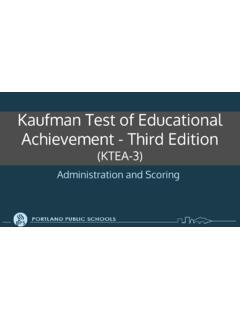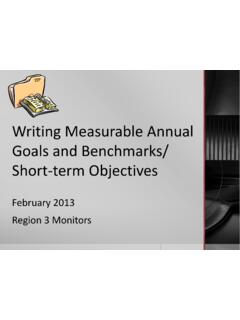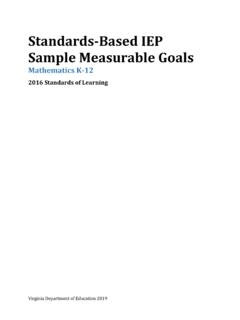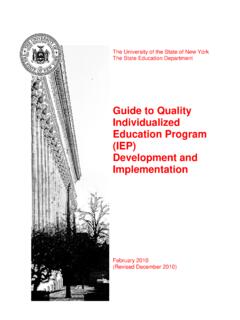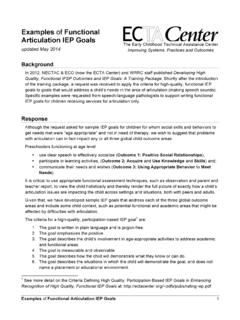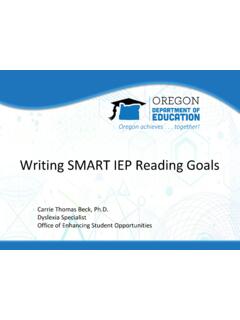Transcription of Sample IEP for Autism - Home | A Day In Our Shoes
1 Statewide Autism Resources and Training (START). IEP Implementation Coaching Checklist Manual Table of Contents In Front Pocket: Passport START IEP Implementation Coaching Checklist Manual Description Tabs: 1. General Information IEP Implementation Coaching Checklist Pacing Guide and Action Plan START Coaching Model & START Coaching PPT. 2. Preparation for the Project Parent Guardian Permission Sample Admin Letter IEP Team and Coach Information CETA. K-12 Target Student Reporting Form Schedule Matrix Universal Supports and Checklist 3. IEP Considerations PLAAFP Worksheet Goal Benchmark Tool Benchmark Examples 4. IEP Implementation Implementation Fidelity Plan K-12 Target Student Reporting Form IEP Implementation Coaching Checklist Manual Description In the START Project, coaching is the primary infrastructure for the implementation of evidence- based practices (EBP). for students with Autism Spectrum Disorder (ASD).
2 This is because training alone is not sufficient for most staff to make practice changes that result in strong implementation fidelity. A coach, then, is an educational professional who assists in developing systems and routines that improve implementation fidelity and provides the teaching, prompting and monitoring of the implementation of the EBP. The START IEP Implementation Coaching Checklist is one way to begin to establish these systems and routines, provide professional development to staff in the process, and create a venue for the teaching and prompting for implementation fidelity of the EBP. The Checklist is intended to be used by an IEP team with a target student with ASD, and the benefits include: Write authentic IEPs for students with ASD. Identify relevant needs (PLAAFP) related to ASD. Implement universal supports Write meaningful measurable goals Efficiently collect and use data Improve team processes (Meeting Mechanics).
3 Increase knowledge of EBP for students with ASD. Increase capacity to implement EBP. Develop a coaching system to improve implementation Improved outcomes for students with ASD and other developmental disabilities This implementation manual is intended to assist building teams in completing the checklist and is organized by tabs that correspond to each step. Within each tab are tools and resources for completing that step. A copy of the checklist itself can be found before tab 1 along with a copy of the START Coaching PowerPoint that details the process. Table of Contents: Passport 1. General Information IEP Implementation Coaching Checklist Pacing Guide and Action Plan START Coaching Model & START Coaching PPT. 2. Preparation for the Project Parent Guardian Permission Sample Administrative Letter IEP Team and Coach Information CETA. K-12 Target Student Reporting Form Schedule Matrix Universal Supports and Checklist 3.
4 IEP Considerations PLAAFP Worksheet Goal Benchmark Tool Benchmark Examples 4. IEP Implementation Implementation Fidelity Plan K-12 Target Student Reporting Form Visit the START website under the Training and Coaching tab for additional resources and tools. 1. General Information Individualized Education Program (IEP) Implementation Coaching Checklist & Guide IEP Implementation Coaching Checklist & Guide Team Leader: Phone: Email: Start Date: This tool is intended to assist Individualized Educational Program (IEP) teams in preparing for, developing, and implementing authentic IEPs for students with ASD. However, information gathered and strategies implemented are part of the START Coaching project and not considered an IEP. Placement decisions and program changes must be made within a formal IEP. As you proceed through the checklist, be sure to use the Pacing Guide and Action Plan form to keep track of action steps related to each step.
5 Review action items at least monthly and at team meetings. IEP Preparation Target Student: Name Grade: Age: Obtain Parent / Guardian Permission for the project (keep signed form on file). Obtain building administrator approval for the project (see Sample Admin Letter for IEP Implementation Coaching). Complete the IEP Team & Coach Information form Evaluate Implementation of Classroom Universal Supports: Implementation of universal supports can have a significant impact on engagement, independence, social opportunities, and behavior for students with ASD. As such, evaluation of the implementation of classroom universal supports and the development of goals in these areas is crucial. Complete the CETA and Identify goals : The CETA (Classroom Environment and Teaching Assessment) is used to evaluate classroom-level universal supports. If the student attends more than one classroom, the tool should be completed for the primary classroom for the purposes of reporting, but can be used for all classrooms.
6 List CETA goals based on areas of need: Collect Target Student Baseline Data Complete the K-12 Target Student Reporting Form RCN and enter data via the survey link (Forms and video directions for the Independence, Engagement and Social data are available on the START Website). Complete a Schedule Matrix for the target student and identify 2-3 primary areas of need: Complete the Universal Supports Checklist and identify needed supports and/or implementation needs: For identified areas of need, collect additional baseline data if needed. Describe additional data: IEP Considerations These considerations do not include all components of the IEP but rather focus on critical areas susceptible to fidelity challenges. Whether or not within a formal IEP, this section should be completed as a team in a meeting format. Elicit Parent Input: It is important for family members to offer input without judgement or reaction from staff.
7 When gathering parent input, do not question, disagree, or give explanation to anything they list as issues, concerns, or wishes. Simply write them all on a white board as they are expressed, and then use the list as a guide throughout the meeting (whether or not it is a formal IEP) to be sure their input is addressed. Highlight parent input: Complete the START Passport: The Passport is a companion tool to the IEP to address skills that may not be related to access and progress in school, but are related to success through school and into adulthood. Discussing Passport goals during the Parent Input section of the IEP is a great way to set the stage for collaboration. After completing the Passport, record information on the Passport Reporting Form. Passport goals : Complete the PLAAFP Worksheet: The PLAAFP worksheet is intended to assist IEP teams in identifying primary areas of student need that prevent student access and progress in the general education curriculum and environments.
8 This information can be also used to identify supplementary aids and services and develop goals . List areas of need: Identify Supplementary Aids and Services: Supplementary aids and services are used to address needs identified in the PLAAFP and serve to support student access to the general education curriculum and environments. As such, universal supports for students with ASD should always be considered and include the following: Visual Schedules and Supports including Self-Management Systems Peer to Peer Strategies and Supports Accommodations and Differentiation including Academic Modifications Functional Communication Systems Positive Behavioral Interventions and Supports including Response Scripts and Break Cards Review the PLAAFP Worksheet and identify supplementary aids and services including evidence- based practices (EBP). needed to address the identified needs, and enhance the student's access and progress in general education curriculum and environments.
9 These supports can also be used to enhance progress on developed goals . List: Develop measurable goals & Benchmarks: IEP goals are intended to address needs listed in the PLAAFP that impact student access and progress in the general education curriculum and environments. Goal areas should be prioritized based on which needs listed in the PLAAFP cannot be met through supplementary aids and services, which needs require specialized instruction ( special education) to address, and/or which are so critical to student learning including access and progress in general education they should have a goal focus. Use the Goal Benchmark Tool to write and benchmark the annual goals (see Benchmark Examples). List developed measurable goals : Implementation and Progress Monitoring Develop an Implementation Fidelity Plan: An Implementation Fidelity Plan will help ensure that interventions and supports identified in previous sections are implemented as designed and intended.
10 Considerations include developing staff competencies in EPB, ongoing training and coaching needed for implementation staff, resources required, and communication feedback systems. Supporting resources for EBP include the National Professional Development Center on ASD, National Autism Center, National Standards Project, AIM Modules, and the NPDC AFIRM Modules. Develop and use the Goal Monitoring Tool: The goal monitoring tool is an efficient way to regularly collect and analyze IEP goal progress data. Should adequate progress not be occurring, revisit the implementation fidelity plan and conduct implementation fidelity checks to ensure interventions, practices and supports are in fact being implemented as designed and intended. If not, make adjustments to implementation and if so, revisit the intensity of the interventions and supports or determine if they should be changed. Determine a monitoring schedule as well who and where the data will be collected.




